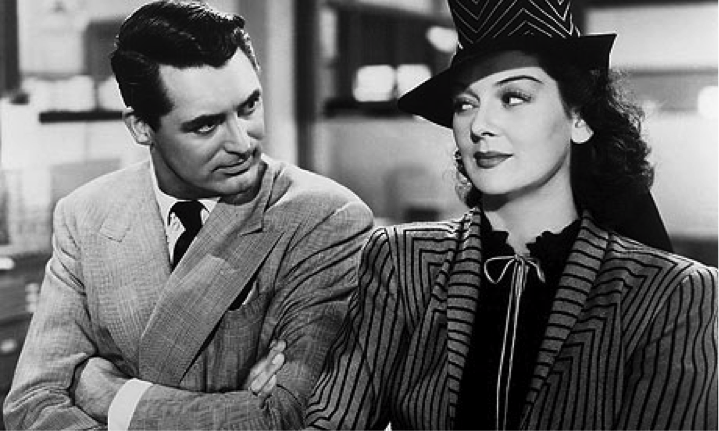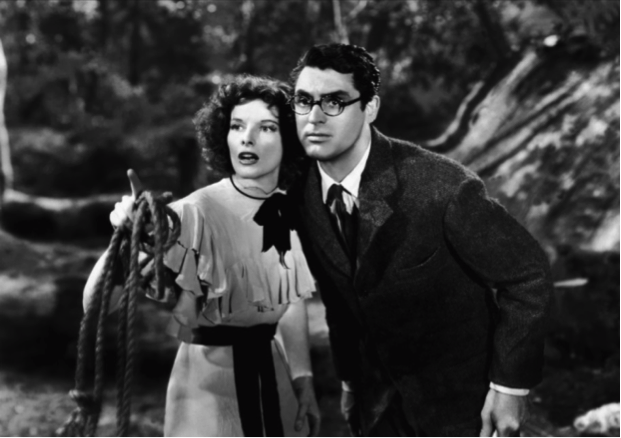What do “Bringing Up Baby” and “His Girl Friday” have in common?
At first glance, director Howard Hawks’ two raucous romantic comedies, Bringing Up Baby (1938) and His Girl Friday (1940), are best known for having in common their leading man (Cary Grant), strong roles for women, and longstanding popularity (currently both are 8/10 on IMDb). When considered through film genre and narrative, however, we can see that they share even more.
I would identify both pictures as anti-domesticity narratives, tales that resist traditionally gendered romantic endings. In classic Hollywood film, romances and romantic comedies generally end with the female lead entirely tamed. Whether she began as a rebel or a shy ingénue, she finishes as an imminent or contented housewife and future mother. In an anti-domesticity narrative, the woman demands something more or other than home life, and the man agrees. His acquiescence may occur because he has a progressive view of marriage, because he has attached himself to a force of nature he cannot resist, or because his needs are best fulfilled with a non-traditional wife. Such specifics may vary, but the romance must still culminate in some promise of happily-ever-after.
His Girl Friday, which follows a female “newspaper man” who realizes she cannot abandon the profession she loves for a future as a housewife (and meanwhile falls back in love with her newspaper man ex-husband), earns its anti-domesticity credentials more easily than Bringing Up Baby, in part because of the stage play it is based on. The 1928 Broadway play The Front Page tells the adventures of two competitive male tabloid reporters. In the original 1931 film version, both the title and the gender of the main characters remain intact. Yet, while the competition remains in the 1940 film adaptation, the duo is changed to male-female. The rewrite heightens tension by emphasizing the former marriage of the two, even as it creates a dynamic, non-traditional female protagonist, played by Rosalind Russell.

Walter (Cary Grant) and Hildy (Rosalind Russell) spur and spark in His Girl Friday (1940)
Both films are examples of the subgenre of “screwball” comedy, a Hollywood romantic comedy of the 1930s or 40s that includes quick repartee and farce within a “battle of the sexes” that ends in successful romance. Screwball elements frame the anti-domesticity narrative well, using broad comedy to soften the impact of the social critique. Moreover, the divorce links His Girl Friday with the “comedy of remarriage,” identified by Stanley Cavell as a subgenre of screwball comedy in which the main characters divorce, dally with others (without breaking Hays Code prohibitions against adultery) and then remarry under more equal terms.
Whether or not we agree that Hildy and Walter have equal power at the end of the film, we see that Hildy ultimately rejects domestic bliss with old-fashioned Bruce Baldwin (Ralph Bellamy), who planned to take her away from her hectic career in a hectic city to be a happy housewife in upstate New York. Although she will have to give up any hopes of peace and quiet, Hildy, like Walter, clearly prefers the excitement and adventure of the newspaper trade as part of any romantic relationship. She returns to Walter but stays a journalist, and that is the heart of this anti-domesticity narrative.
Bringing Up Baby, the earlier of the two films, resists narratives of domesticity less obviously but in some ways more radically than His Girl Friday. Walter tricks and coerces Hildy into leaving Bruce, fulfilling a traditional aggressive masculine role. Hildy is Walter’s equal in vitriol, but Walter dominates her life, leading Hildy back to his arms and where he wants her. That he wants her in the newspaper game, chasing leads rather than changing diapers, links the film with the anti-domesticity narrative but does not erase the gendered power imbalance between them. By contrast, in Bringing Up Baby, the female is the aggressor who gets what she wants from the man she chooses (and chases) throughout this anti-domesticity tale.

Susan (Katharine Hepburn) takes David (Cary Grant) on an adventure to non-traditional romance in Bringing Up Baby (1938)
In comparison to Russell’s Hildy Johnson, Hepburn’s Susan Vance is not a career woman. Her inherited wealth and class privilege allow her to spend her time as she wishes, engaged in activities such as golfing and dining at the club. The man she pursues after a comedy-of-errors style introduction is Cary Grant’s Dr. David Huxley, a shy, bookish man who is all work and no play. The bespectacled scientist David is concerned only with his work in paleontology. And when he occasionally thinks of other matters, such as romance, he is quickly put in his place by his prim assistant-cum fiancée, Alice Swallow (Virginia Walker), who is even more work-driven than David. Her plans for their marital bliss demand “no entanglements of any kind,” including sexual intimacy and the offspring that might produce. While both characters oppose the traditional domesticated type, Miss Swallow displays no pleasure in what she does, only a determined sense of duty. Susan, on the other hand, seems to seek only pleasure, and the pursuit of pleasure triumphs in this film.
A central symbol of resistance to domesticity is the film’s titular “baby,” which turns out to be a tamed leopard that Susan’s brother has sent to her for safekeeping. Domesticity is exchanged for slapstick wildness, and Susan takes David on the ride of his life. Susan shows no predisposition toward domestic bliss beyond claiming the man she loves and enjoying the chaos. Her perspective is echoed in the jazz standard they repeatedly sing to calm the leopard:
I can’t give you anything but love, baby
That’s the only thing I’ve plenty of, baby
Dream a while, scheme a while
I’m sure you’ll find
Happiness, and I guess
All those things you’ve always pined for
Susan can be neither the traditional housewife nor the terse helpmate who will ensure his career flourishes. She offers only a crazy kind of love, but it turns out that’s what’s best for tightly wound David. In the final scene, Susan destroys David’s dinosaur and then speaks for him, offering his words of forgiveness and declaration of love. She’s the dreamer and the schemer of the song, and she has led him to recognize that what he’s “always pined for” is the chaos she offers. David’s resigned “Oh well” and embrace in response is in many ways the equal and opposite of Hildy’s resignation as she realizes Walter will never take her on a honeymoon though neither will he condemn her to the life of a housewife. David’s reciprocating Susan’s love is portrayed as more of a capitulation than an active choice. In this resolution, we see that Susan and David have reversed traditional gender roles, not in a career sense but in an intra-relational sense, whereas Hildy and Walter still follow some of our assumptions about masculine and feminine behavior within couples.
By considering these two screwball comedies together, we see similar challenges to the gender politics of domesticity within different narratives. Hildy is the career woman encouraged to recognize her destiny by a manipulative man. Susan is manipulative, too, but she’s also a free spirit who leads her man to enjoy a non-traditional romance. In Hawks’ famous pair of romantic comedies, then, we get Hollywood happily-ever-afters that neatly avoid the relegation of women to marriage and the home.

